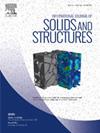基于扩展局部精确均质理论的聚合物基压电复合材料/纳米复合材料的时效有效特性和局部物理场
IF 3.4
3区 工程技术
Q1 MECHANICS
International Journal of Solids and Structures
Pub Date : 2025-03-29
DOI:10.1016/j.ijsolstr.2025.113365
引用次数: 0
摘要
本文将复合材料的微观力学模型(局部精确均质理论- LEHT)扩展到压电时域,利用电弹性-粘电弹性对应原理预测聚合物基压电/纳米复合材料含能表面的时效有效性能和局部物理场。采用广义Gurtin-Murdoch (G-M)模型对压电纳米复合材料界面进行建模,同时考虑了界面应力和电位移的不连续。该方法将边值问题和复合均匀化本构方程引入拉普拉斯域求解,然后采用数值稳定的Zakian方法将宏观和微观响应转换为时域,避免了粘电弹性本构方程以含积分形式逐级迭代。该方法与文献中推广的Eshelby解和渐近均匀化方法(AHM)的一致性验证了该方法的准确性。最后,采用不同的流变模型分析了基体粘弹性、纤维/基体体积比、温度和界面参数对压电/纳米复合材料长期有效性能和局部响应的影响。结果表明,该方法不仅可以有效地预测压电材料的长期性能,而且可以准确地恢复具有代表性的单元胞(RUCs)的局部应力和电位移分布。此外,界面效应的研究为理解和优化压电复合材料的实际性能提供了理论支持。这些结果有助于它们在传感器、执行器和能量收集器领域的效率和稳定性。本文章由计算机程序翻译,如有差异,请以英文原文为准。
Time-dependent effective properties and local physical fields of polymer-based piezoelectric composites/nanocomposites via extended local-exact homogenization theory
In this paper, the micromechanics model (local-exact homogenization theory – LEHT) for composites is extended to the piezoelectric time domain to predict the time-dependent effective properties and local physical fields of polymer-based piezoelectric composites/nanocomposites with energetic surfaces using the electroelastic-viscoelectroelastic correspondence principle. The interface is modeled using a generalized Gurtin-Murdoch (G-M) model for piezoelectric nanocomposites, taking into account of discontinuities of both interface stresses and electrical displacement. The method introduces the boundary-value problem and the composite homogenization constitutive equations into the Laplace domain for solutions, and subsequently transforms the macroscopic and microscopic responses into the time domain by a numerical-stable Zakian method, which avoids step-by-step iteration of the viscoelectroelastic constitutive equations in an integral-containing form. The consistency between the proposed method and the extended Eshelby solution and Asymptotic Homogenization Method (AHM) in the literature validates the accuracy of the approach. Finally, different rheological models are used to analyze the effects of matrix’ viscoelastic properties, fiber/matrix volume ratio, temperature and interfacial parameters on the long-term effective performance and local responses of piezoelectric composites/nanocomposites. The results demonstrate that this method not only efficiently predicts the long-term properties of piezoelectric materials but also accurately recovering the local stress and electric displacement distributions in the representative unit cells (RUCs). In addition, the study of interfacial effects provides theoretical support for understanding and optimizing the practical properties of piezoelectric composites. These results contribute to their efficiency and stability in the field of sensors, actuators and energy harvesters.
求助全文
通过发布文献求助,成功后即可免费获取论文全文。
去求助
来源期刊
CiteScore
6.70
自引率
8.30%
发文量
405
审稿时长
70 days
期刊介绍:
The International Journal of Solids and Structures has as its objective the publication and dissemination of original research in Mechanics of Solids and Structures as a field of Applied Science and Engineering. It fosters thus the exchange of ideas among workers in different parts of the world and also among workers who emphasize different aspects of the foundations and applications of the field.
Standing as it does at the cross-roads of Materials Science, Life Sciences, Mathematics, Physics and Engineering Design, the Mechanics of Solids and Structures is experiencing considerable growth as a result of recent technological advances. The Journal, by providing an international medium of communication, is encouraging this growth and is encompassing all aspects of the field from the more classical problems of structural analysis to mechanics of solids continually interacting with other media and including fracture, flow, wave propagation, heat transfer, thermal effects in solids, optimum design methods, model analysis, structural topology and numerical techniques. Interest extends to both inorganic and organic solids and structures.

 求助内容:
求助内容: 应助结果提醒方式:
应助结果提醒方式:


